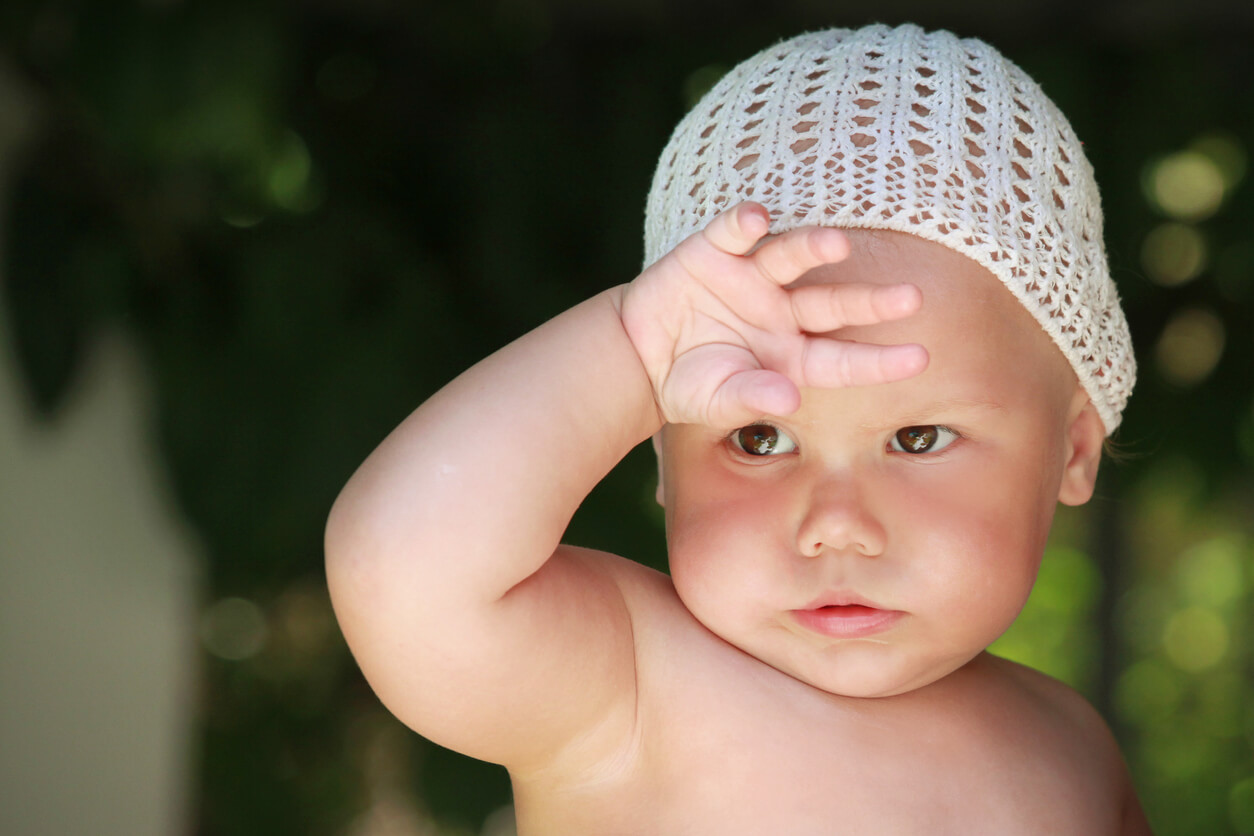How to Avoid Skin Irritation in Babies?


Written and verified by the dermatologist Maria del Carmen Hernandez
Skin irritation in babies is a fairly common condition due to the different characteristics compared to those of adults. Therefore, injuries and irritations occur quite easily during this stage of life. However, their skin surface has the ability to recover quickly with the implementation of a few measures.
Babies’ skin
Babies’ skin barrier is competent at birth and matures during the first few years of life. Throughout this process, it’s essential to get the skin care products right. In addition to being a physical barrier, some of the important functions of the skin surface of little ones include the following:
- Thermoregulation
- Maintaining adequate hydration
- Gas exchange
- Immune function and protection against pathogens
You may be interested in: Skin Rashes on Babies: What You Should Know
These are the most common types of skin irritation in babies
Newborn skin is more susceptible to irritation or dermatitis. This is because the skin barrier isn’t yet fully developed.
Atopic dermatitis
Atopic disease is a specific form of eczema characterized by chronic inflammation of the skin. It appears in the form of itching, dry skin, eczematous lesions, and sometimes lichenification. In 60% of cases, it occurs from the age of one year, and the most frequent locations are the cheeks, forehead, and extremities.

Skin irritation in babies due to sweat
Babies tend to sweat more than usual due to their heightened response to temperature changes. Therefore, these droplets irritate the skin pores and develop a superficial rash. Sudamen is characterized by tiny pimples in the regions of the body where there is high temperature. It also appears on the back, upper trunk, or elbow creases.
Diaper rash
Diaper rash is the most common skin condition among infants. It’s characterized by irritated skin with signs of erythema or minimal redness on diaper-covered areas of the body.
It’s most prevalent in children under 12 months of age. In turn, more severe cases may include scaly foci or even slight bleeding. Therefore, the use of emollients and diapers that don’t keep the area moist is recommended, according to a publication by Pediatric Dermatology.
Recommendations to avoid skin irritation in babies
Babies’ skin is much more delicate and fragile than that of adults, which requires greater care and protection to avoid irritation. For this reason, the basic and simple advice is based on keeping the baby’s skin clean and dry.
Choosing the right hygiene products
It’s best to choose products to use on babies that don’t alter the pH of the skin surface or interfere with the protective barrier. For example, it’s advisable to use mild soaps, without chemicals or additives. In fact, maintaining the skin barrier is critical for survival, as babies’ skin is more susceptible to infection.
Perform a good diapering routine
Routine diaper changing keeps the skin in the area in optimal condition. It also prevents urine, fecal matter, or sweat from staying too long in contact with the skin. In addition, drying the entire area properly after each change and using specific products is also a good indication.

Take care when bathing
When bathing a baby, the use of mild soaps with non-irritating surfactants that are close to the pH of the skin is recommended. Also, warm water should be used and its duration should be short to prevent dryness and irritation. Afterward, it’s best to dry the skin with gentle touches without rubbing or generating friction.
Moisturize the skin constantly and daily
Moisturizing helps to maintain the skin barrier undamaged, functional, and healthy. For this reason, it’s best to apply emollient all over the body after bathing. If needed, it can be reapplied during the day in those areas that are flaky or dehydrated.
Choosing the right clothing
Excessive clothing on babies may favor the development of irritations all over the body. It’s also advisable to choose clothing made of breathable and natural materials, such as cotton or linen. In addition, clothes should be washed with a gentle product that’s free of chlorine, bleach, and strong detergents.
Read also: Tips for Washing Your Baby’s Clothes
Skin irritation in babies and its evolution
In most cases, skin irritation in babies doesn’t involve fever. However, when it’s accompanied by various signs and symptoms, a pediatrician should be consulted. A professional should also be consulted in those cases of dermatitis in which no improvement is observed or the condition doesn’t improve with the measures implemented.
Skin irritation in babies is a fairly common condition due to the different characteristics compared to those of adults. Therefore, injuries and irritations occur quite easily during this stage of life. However, their skin surface has the ability to recover quickly with the implementation of a few measures.
Babies’ skin
Babies’ skin barrier is competent at birth and matures during the first few years of life. Throughout this process, it’s essential to get the skin care products right. In addition to being a physical barrier, some of the important functions of the skin surface of little ones include the following:
- Thermoregulation
- Maintaining adequate hydration
- Gas exchange
- Immune function and protection against pathogens
You may be interested in: Skin Rashes on Babies: What You Should Know
These are the most common types of skin irritation in babies
Newborn skin is more susceptible to irritation or dermatitis. This is because the skin barrier isn’t yet fully developed.
Atopic dermatitis
Atopic disease is a specific form of eczema characterized by chronic inflammation of the skin. It appears in the form of itching, dry skin, eczematous lesions, and sometimes lichenification. In 60% of cases, it occurs from the age of one year, and the most frequent locations are the cheeks, forehead, and extremities.

Skin irritation in babies due to sweat
Babies tend to sweat more than usual due to their heightened response to temperature changes. Therefore, these droplets irritate the skin pores and develop a superficial rash. Sudamen is characterized by tiny pimples in the regions of the body where there is high temperature. It also appears on the back, upper trunk, or elbow creases.
Diaper rash
Diaper rash is the most common skin condition among infants. It’s characterized by irritated skin with signs of erythema or minimal redness on diaper-covered areas of the body.
It’s most prevalent in children under 12 months of age. In turn, more severe cases may include scaly foci or even slight bleeding. Therefore, the use of emollients and diapers that don’t keep the area moist is recommended, according to a publication by Pediatric Dermatology.
Recommendations to avoid skin irritation in babies
Babies’ skin is much more delicate and fragile than that of adults, which requires greater care and protection to avoid irritation. For this reason, the basic and simple advice is based on keeping the baby’s skin clean and dry.
Choosing the right hygiene products
It’s best to choose products to use on babies that don’t alter the pH of the skin surface or interfere with the protective barrier. For example, it’s advisable to use mild soaps, without chemicals or additives. In fact, maintaining the skin barrier is critical for survival, as babies’ skin is more susceptible to infection.
Perform a good diapering routine
Routine diaper changing keeps the skin in the area in optimal condition. It also prevents urine, fecal matter, or sweat from staying too long in contact with the skin. In addition, drying the entire area properly after each change and using specific products is also a good indication.

Take care when bathing
When bathing a baby, the use of mild soaps with non-irritating surfactants that are close to the pH of the skin is recommended. Also, warm water should be used and its duration should be short to prevent dryness and irritation. Afterward, it’s best to dry the skin with gentle touches without rubbing or generating friction.
Moisturize the skin constantly and daily
Moisturizing helps to maintain the skin barrier undamaged, functional, and healthy. For this reason, it’s best to apply emollient all over the body after bathing. If needed, it can be reapplied during the day in those areas that are flaky or dehydrated.
Choosing the right clothing
Excessive clothing on babies may favor the development of irritations all over the body. It’s also advisable to choose clothing made of breathable and natural materials, such as cotton or linen. In addition, clothes should be washed with a gentle product that’s free of chlorine, bleach, and strong detergents.
Read also: Tips for Washing Your Baby’s Clothes
Skin irritation in babies and its evolution
In most cases, skin irritation in babies doesn’t involve fever. However, when it’s accompanied by various signs and symptoms, a pediatrician should be consulted. A professional should also be consulted in those cases of dermatitis in which no improvement is observed or the condition doesn’t improve with the measures implemented.
All cited sources were thoroughly reviewed by our team to ensure their quality, reliability, currency, and validity. The bibliography of this article was considered reliable and of academic or scientific accuracy.
- Weidinger S, Novak N. Atopic dermatitis. Lancet. 2016 Mar 12;387(10023):1109-1122. doi: 10.1016/S0140-6736(15)00149-X. Epub 2015 Sep 13. PMID: 26377142.
- Blume-Peytavi U, Kanti V. Prevention and treatment of diaper dermatitis. Pediatr Dermatol. 2018 Mar;35 Suppl 1:s19-s23. doi: 10.1111/pde.13495. PMID: 29596731.
- Blume-Peytavi U, Hauser M, Stamatas GN, Pathirana D, Garcia Bartels N. Skin care practices for newborns and infants: review of the clinical evidence for best practices. Pediatr Dermatol. 2012 Jan-Feb;29(1):1-14. doi: 10.1111/j.1525-1470.2011.01594.x. Epub 2011 Oct 20. PMID: 22011065.
This text is provided for informational purposes only and does not replace consultation with a professional. If in doubt, consult your specialist.








